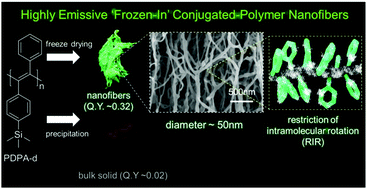Highly emissive ‘frozen-in’ conjugated polymer nanofibers†
Abstract
Conjugated-polymer nanofibers with a thermodynamically stable, coarsened, disordered structure in an amorphous glassy state were fabricated via a freeze-drying method using a poly(diphenylacetylene) derivative. The nanofibers were extremely emissive, with a fluorescence (FL) quantum yield of approximately 0.34, which was much higher than that of both the cast film (0.02) and the solution (0.21). Similarly, the amplitude-weighted average FL lifetime of the nanofibers was 0.74 ns, which was much longer than that of the film (0.29 ns) and the solution (0.57 ns). This unusual and enhanced FL-emission behavior was attributed to the abruptly quenched chain structure that was created by the freeze-drying process. The polymer chains in the nanofibers remained frozen-in and the side phenyl rings were retained in a relaxed state. The metastable chains did not undergo vibrational relaxation and collisional quenching to generate the radiative emission decay effectively.


 Please wait while we load your content...
Please wait while we load your content...